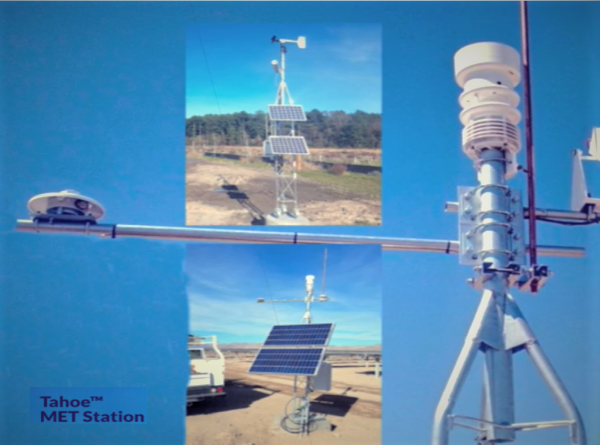Solar power generation is significantly influenced by local weather conditions and a proper understanding of these relations is important to ensure that solar energy is a fiscally and environmentally sustainable source of renewable energy. A weather station can be defined as a facility with instruments and equipment, used to make observations of atmospheric conditions to facilitate weather forecasting to study the weather and climate.
On-site Meteorological (MET) Stations at a PV-Solar site, provide quality meteorological data that can help measure the amount of solar radiation as it reaches the surface of the PV modules. This helps to analyze and measure what part of solar radiation is converted into electricity for a given module configuration. With real-time data, operators can monitor any decline in power generation that may affect energy output and ROI.
Solar irradiance measurements are helpful in site selection for PV-Solar plants, calculations of efficiency in plant operation, as well as determining possible improvements of power plant setups.
Solar radiation can be transmitted, absorbed, or scattered in varying amounts by an attenuating medium that depend on wavelengths. Based on interactions between the radiation and the atmosphere, three fundamental components of interest are:
- Direct normal irradiance (DNI): A solar (beam) radiation from the sun’s disk itself.
- Diffuse horizontal irradiance (DHI): Scattered solar radiation from the sky dome (excluding the sun and the DNI).
- Global horizontal irradiance (GHI): Geometric sum of the direct and diffuse components (also called total hemispheric irradiance).
GHI is measured by installing pyranometer on a horizontal surface because the measurement includes diffused and directly incident light, it can be described by the DHI and DNI. The geometric sum of the components can be written as:
GHI = DNI * Cos(Z) + DHI where Z is the solar zenith angle of the sun at the time of the measurement.
GHI is almost always a measurement captured by a solar Met Station, along with measuring plane of array (POA). POA measurements are taken with pyranometer installed in the same plane as the solar panel. It’s very common to use multiple POA pyranometers to measure light incident in the plane of the solar panels.
POA can also be calculated using the GHI, DNI, and DHI measurements using the following equation:
POA = DNI * Cos(AOI) + Diffuse + Reflected where AOI is the solar incidence angle.
The IEC 61724-1 standard is a guideline established to promote international uniformity in PV system performance monitoring. This completely revised and updated version introduces a monitoring system classification that specifies measurement parameters and sensor requirements, according to the PV project size and/or monitoring objectives. It also presents standardized methodologies for performing soiling measurements and calculating soiling loss indices.
The quantity of MET stations required for a site is dependent on the size/capacity (in MWac) and geographical spread or layout of the site. Per industries best practices, it is recommended to have 2 METS for first 20MW, and 1 additional MET thereafter for every 40MWac of capacity.
Instruments designed to measure any form of radiation are called radiometers. Pyrheliometers and Pyranometers are two types of instruments used to measure solar irradiance.
- Pyranometers are used to measure GHI, DHI or Plane of Array Irradiance (POA), mounted horizontally to measure GHI. These can be mounted at a tilt to measure POA irradiance. In an inverted position, it measures the reflected irradiance, also known as albedo.
- Pyrheliometers are used to measure DNI. These are mounted on automatic solar trackers to maintain the instrument’s alignment with the solar disk, to fully illuminate the detector from sunrise to sunset.
When it comes to determining the efficiency of a solar plant, measurements of solar irradiance are crucial. But to have a better handle on plant performance, it’s also crucial to monitor other weather parameters that can have a direct impact like:
Module temperature: As a general rule of thumb, efficiency of a typical PV module drops at around 0.5% for every degree the temperature rise above 25°C. Back of Module (BOM) sensors are used for monitoring module temperature.
Ambient air temperature, air pressure, dew point and relative humidity, precipitation, wind direction and Speed also have an impact on the performance of the plant. All the previously mentioned measurements can be monitored by using an All-in-One sensor.
Soiling: Energy generation losses due to dust, sand, pollen, salt, and other particulates on a PV surface are called PV soiling losses. A soiling station, or soiling sensor, is used to help operators determine when and where panels need cleaning. It is a way of assisting PV plant operators and quantifying power loss.
A MET station or Weather Monitoring Station (WMS) is one of the key components in a PV-Solar power plant, and they are crucial in measuring the efficiency and performance of solar PV sites. There have been various sensor configurations used for on-site MET stations. There is no upper limit on how many configurations various sensors can be used for. For larger sites, in addition to full MET stations, a trend of having distributed MET sensors is seen where primarily POAs and BOMs are spread across the site to have as much quality data as possible.
Nor-Cal offers custom built TAHOETM MET stations to meet specific site requirements. We can adhere to a wide range of specifications, regarding the selection of sensors and overall configuration for the MET station. The TAHOETM comes with a datalogger to monitor and record change in condition over time, RS485 HUBs for opto-isolated sensor connections, UPS power supply with surge suppressor, battery backup and solar panel back up.
Get in touch with us to discuss your upcoming project needs relating to MET stations, or SCADA Systems for existing or upcoming PV-Solar BESS sites.
Collaborator: Troy Morlan





